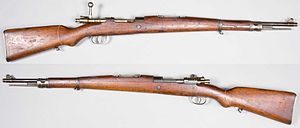M24 series
| M24 series | |
|---|---|

Rifle Model 1924, from the collections of the Swedish Army Museum.
|
|
| Type | Bolt-action rifle |
| Place of origin |
|
| Service history | |
| In service | 1924-1950s |
| Used by |
Kingdom of Yugoslavia Nazi Germany Independent State of Croatia SFR Yugoslavia |
| Wars |
World War II Greek Civil War |
| Production history | |
| Manufacturer | FN Herstal, Kragujevac Arsenal |
| Produced | 1924-1929, 1929-1941 |
| No. built | approx. 780.000 |
| Specifications | |
| Length | 110 centimetres (43 in) |
| Barrel length | 50.4 centimetres (19.8 in) |
|
|
|
| Cartridge | 7.92×57mm Mauser |
| Action | Bolt-action |
| Muzzle velocity | 760 m/s (2,493 ft/s) |
| Effective firing range | 500 m (550 yd) (with iron sights) >800 m (870 yd) (with optics) |
| Feed system | 5-round stripper clip, internal magazine |
| Sights | Iron sights or telescopic sight |
The M24 series is a line of Mauser pattern bolt-action battle rifles produced for use by the Yugoslavian military. They are similar to the Czech vz. 24 rifle, featuring open sights, 8×57mm IS chambering, carbine-length barrels, hardwood stocks, and straight bolt handles. All M24 series weapons are designed to accept the M-24/48 pattern bayonet.
The first Mauser-pattern rifle produced in Yugoslavia was the M24. Its predecessor, the FN Model 1924 had been produced for the Yugoslav army by FN Herstal until the Ministry and FN signed a contract on the purchase of the licence for production of rifles 7.9 mm M 24. Nearly all M24's were produced either before or during World War II, at the Kragujevac Arsenal plant. The M24 and Model 1924 are nearly identical.
The final additions to the M24 family were the M24/47 and M24/52 rifles. Both were produced by reworking existing prewar Serbian Model 24 Mausers and then refurbished with newer Belgian parts during World War II at the Zastava Arms (formally Kragujevac Arsenal) plant, which was at that time under the control of the postwar communist government. "47" and "52" indicate the beginning of the rebuild program for each respective model: 1947 for the M24/47 and 1952 for the M24/52. One common misconception is that the M24/47 rifles were produced only in 1947; actually, the rebuild program lasted into the early 1950s alongside new production of M48 rifles. Minor cosmetic differences exist between the M24/47 and M24/52, but the rifles are nearly identical to one another and to their predecessors, the Model 1924 and M24.
M24 series rifles were used by the Royal Yugoslav Army and by nearly all sides during World War II in Yugoslavia.
A number of M24 series rifles have been sold to civilians, and are popular because of their low cost when compared to similar Mauser pattern rifles, such as the Nazi German Karabiner 98k. M24 series rifles are noted for their high quality and generally bright bores. Many have compared the M24/47 rifles to the M48 Mausers, which were built later than the M24 series. The M24/47 stocks are mostly made of thinner Walnut or Teak wood in the old German style, unlike the M48s, which are made in the Nazi German 98k style with thick Elm or Beech wood, and the M24/47s do not have a milled stainless steel "cupped" butt plate like the M48. Both rifles have a shorter intermediate-length receiver. M24 series rifles, like the M48 Mausers, are regarded as a military surplus firearm and can be collected in the USA, Canada and Australia at a generally cheap price due to the plentiful numbers recently imported from Europe, most of which had never been used in combat.
...
Wikipedia
